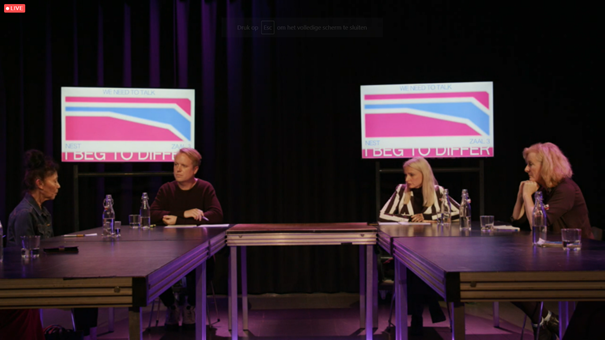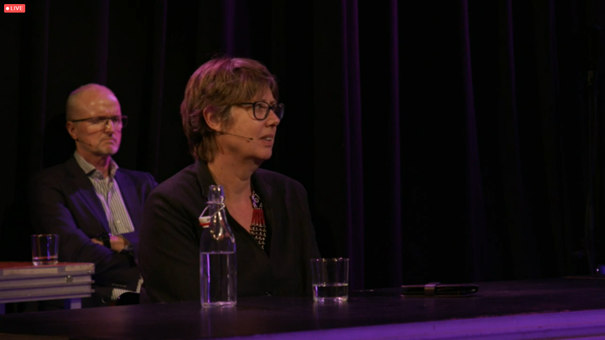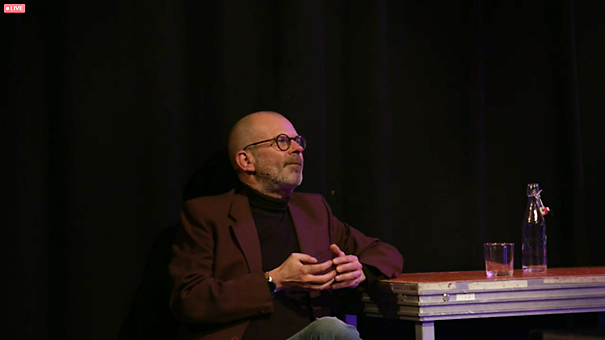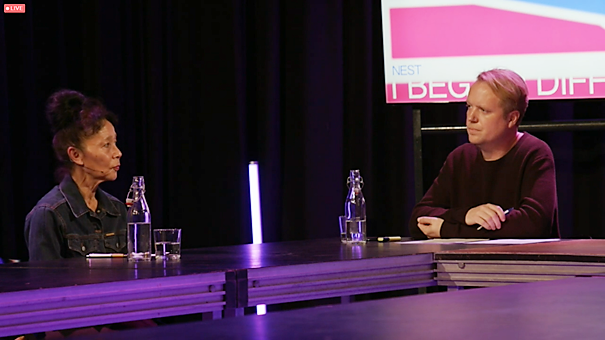
‘We need to talk’ – Nest and Zaal 3 organise a panel discussion about the Andeweg case
If the Andeweg case and its aftermath make one thing clear, it is that safe working environments in the visual arts sector are far from being the norm. Yesterday evening Heske ten Cate (Nest) and John de Weerd (Zaal 3) headed up a carefully prepared panel discussion in which they were joined, besides by the journalists of the NRC, by a lawyer, a detective from the vice unit, a confidential counsellor and a project leader. The key focus was on the question: how can we adequately protect victims?
A discussion yesterday evening in Zaal 3 about ensuring a safe working climate within the visual arts sector was attended by a striking number of people working outside the sector. The multiple accusations of stalking, violence, sexual assault and rape against Julian Andeweg had led them, in a variety of ways, to enter the art world: in the role of a lawyer who represents victims of sexual violence (Margreet de Boer), investigative journalist (Carola Houtekamer), confidential counsellor at the reporting centre for undesirable forms of behaviour Mores (Freek Walther) or detective in the Amsterdam vice unit (Jan de Jong).
The panel discussion I Beg to differ – We Need to Talk goes far beyond the sector, and that is a good thing, too. Partly because this way cross-sectorial, structural sexism can be addressed, but above all because this makes it possible to take a fresh, sometimes relativistic but often also astonished look at the world of visual arts. People’s apparent inability to hold one another accountable for inappropriate behaviour within the sector was discussed with consternation, and proved to be a sensitive issue for the other two participants, Lucette ter Borg and Jane Huldman, as well.
Both of them have been working in the art world for years; Ter Borg as an art and investigative journalist and Jane Huldman as a project leader at Stroom in The Hague, an institution which grants subsidies and puts on exhibitions where Andeweg was given a platform on two occasions.
The evening was explicitly set up as a ‘prologue’. There is no need to debate the issue of toxic working environments which facilitate sexual violence, say moderators Heske ten Cate (Nest) and John de Weerd (HNT/ Zaal 3): nobody wants a workplace like that. However, reality continually proves to be more problematic. The Andeweg case makes it clear that many working environments in the art world are unsafe. The suggestion in the NRC report is that this is even more so than elsewhere, starting with the art academies, which since the publication have been urgently investigating just how safe their learning environment, which was thought to be so safe, actually is. The session is a first step towards answering, or at least formulating, painful questions. Are the existing protocols, if they already exist, falling short of the mark? Has the ‘trial by media’ which has surfaced in recent weeks exposed a failing legal system? And above all: how can we adequately protect victims?
[blockquote]The Andeweg case makes it clear that many working environments in the art world are unsafe. The suggestion in the NRC report is that this is even more so than elsewhere, starting with the art academies

HEAR BOTH SIDES
Tonight people make an effort to think from the victim’s perspective. Ter Borg and Houtekamer start the evening with a report on their investigation process. It already became clear to them at the start of the process that the accusations were serious and large in scale. From then on, they together start to check each accusation precisely: they are looking for witnesses, apps or invitations to parties that are capable of supporting the story and the timeline of the offence described. They verify claims with eyewitnesses. Yesterday evening they stated that everything that is being claimed has been verified. Maybe not yet examined judicially, but without doubt true.
Why did you present the acts so ‘graphically and in such detail’? asks Ten Cate. What motivated this journalistic choice? Ter Borg and Houtekamer explain that in order to be able to present any sort of a picture in an article of how, as a victim, you can gradually be sucked into a destructive relationship, it is important that you tell the whole story; including painful and shameful elements. If the story had been cast in general terms it would also have been less transparent. By reporting in detail, you make it harder for people to disregard the article as well; it makes the report more compelling. The urgency to expose the whole story this way is also inspired by the long period of time that the violence extends over, says Ter Borg. That indicates that the cultural context in which this sexual violence was facilitated looked the other way for a long time, in spite of numerous signals.
They say that a lengthy process of hearing both sides followed, after the accusations were listed in the text. They remember how friends who initially supported Andeweg through thick and thin dropped him like a hot brick after reading parts of the accusations, and confessed to having been aware of certain signals for a while.
The question that has occupied the minds of many people is why they deviated from the generally accepted practice of not naming a suspect in full in an article – after all, a suspect is innocent until proven guilty in court, are they not? Houtekamer answers by summing up the considerations behind the decision. The choice to leave out the suspect’s surname or to replace it with an initial doesn’t make sense in view of the highly detailed way in which that suspect’s life is described in the article, she explains. Apart from the fact that a name like that could be discovered with two clicks on the internet, reporting the name was also a way to make clear who it was not about, and in this way to protect artist-friends that Andeweg worked with extensively. In the end, the seriousness and duration of the violence, alongside the fact that it concerned a public figure, were the deciding factors.
Ten Cate asks advocate De Boer what she thinks of this idea of naming the perpetrator when you go public with your story. De Boer answers that you must always be able to explain what your intention is in naming names: if this is just to damage someone, then that is not permitted. It is difficult to state where the boundary lies, but instinctively it is fairly clear, she says. There is a difference between the justifiable interest of victims wishing to tell their story and the unjustifiable interest of simply wishing to damage someone.
De Boer is defending the victims in the Andeweg case and cannot comment on that ongoing case this evening. However, she does clearly describe how it came about that charges were pressed, when Ten Cate asks about this. ‘There is another question to be asked beforehand’, says De Boer, namely: ‘am I going to press charges?’ She says why this is important: by asking that question, the victim regains some of the control that has been taken away from her in the violence that she has had to endure. If the victim decides to press charges this can be a way of setting your own boundaries. If all you are seeking to do is to see the perpetrator behind bars, De Boer warns, then at that moment ‘you are organising your own disappointment’.
By leaving the question 'am I going to press charges?' up to the victim she regains some of the control that was taken away from her in the violence she has had to endure

Sex offenders are difficult to convict, she explains, because you have to prove conclusively and legally that a crime has been committed. Not everything that is experienced as unwanted sex is a crime in legal terms. There are some clear rules though: it is an offence to have sex with a victim who is unconscious; it is an offence to have sex if it is accompanied by (the threat of) violence, and it is an offence if there is some form of false imprisonment. You have to establish that the victim’s resistance was overcome and this needs to be supported by, for example, a so-called disclosure witness (someone that the victim first talks to about the crime), demonstrable injury, DNA traces or apps that have been sent. However, there is currently a proposal for legislation that is intended to make sex against your will, but without violence, a criminal offence, see here.
Ten Cate notes the trend that many victims bring out their story by other means rather than by pressing charges. And the phenomenon of Trial by Media, which has been shown to be an effective instrument for #MeToo. Isn’t that a sign of a failing justice system? Or the lack of a reporting mechanism within institutions? There seems to be little room for properly and satisfactorily safeguarding victims’ stories.
De Boer, who previously had little knowledge of the art world, says that she does not want to generalise, but that she was astonished by how few reporting mechanisms and protocols there were in the field. Maybe this is due to the specific way in which the employment sector is structured: with many freelance contracts and fewer employer-employee relationships. But this is also true in the world of sport, and in that case there is an extensive network of reporting mechanisms, says De Boer. The visual arts could learn from that.
De Weerd and Ten Cate put the issue of this trend to the Amsterdam vice unit detective De Jong and ask him how it is possible that, after submitting a complaint to the police, victims often come away disappointed, feel like they have not been listened to, and therefore increasingly look for other channels. De Jong puts that feeling down to the critical questions which the victim has to be asked in an initial interview, in order to ascertain the provability of the offence. By means of forensic investigation and informative interviewing, an attempt is made to determine how ‘promising’ a complaint is. It is a procedure that victims can have difficulty with, but is based on good intentions, he explains. Houtekamer and Ter Borg ask him about the fact that both investigation this summer and their article revealed that many victims feel – consciously or unconsciously – discouraged from pressing charges. Besides this, a victim who does press charges often receives no updates for months, giving her the feeling that nothing seems to happen with her filed report. How can this be? De Jong states that in any case 60-70% of the reports should be fully investigated and ready for prosecution in six months.
The importance is stressed of a business culture that has to change: institutions and academies must be able to consult each other. This is a shared problem that calls for a shared approach

MACHO CULTURE
Although the suggestion here is that the actions of the police are falling short of the mark, the criticism remains friendly: the aim of the evening is to identify the various elements that contribute to the problem. One such element is also the educational climate within the art academies, where a macho culture often still rules. That perspective is lacking from the table here; despite regular attempts by the organisation, KABK did not wish to take part, the moderators explain. In the end, a film is shown in which De Weerd has a discussion with the director of Maastricht Drama Academy Rob Ligthert, who has pressed the need for a code at the academy. A heartfelt attempt to include the educational perspective, which however does not fully do justice to the important role that academies and post academic institutions play within this problem. The fact that sexism exists in the art academy climate can be seen from the instagram account Call Out Dutch Institutions, where many different students brought testimonies of experienced sexism to light. The account has now been put on hold and visitors are referred to the online reporting point for ‘undesirable forms of behaviour in the performing arts, television and film sector, art education and museums’ Mores. Just like everyone now, by the way: after the publication of the article, the art sector quickly became aware of the existence of Mores, a reporting centre that lends a listening ear to victims in case of, among other things, undesirable sexual behaviour.
Confidential counsellor Freek Walther says that Mores is often a last resort for victims – people making reports have already approached institutions. If victims call them they can count on a completely confidential discussion. In that conversation, the person calling is told what they could possibly do in their situation, says Walther. He stresses that, above all, they listen and do everything they can to ensure that the victim retains control. A member of the audience asks whether that emphasis on personal control really protects the mental health of the victim. Because isn’t it poignant that just when you are feeling traumatised you are expected to make a lot of decisions: both by the police and by reporting centres? De Boer understands the question; the fact that it is important that nobody tells you what to do and what not to do doesn’t diminish the fact that it is also very important that you are cared for. By the Centre for Sexual Violence, for example, or by psychologists and GPs.
With his experiences as a confidential counsellor in hospitals and in education, Walther also counts as a relativising voice: sexism is an issue in other sectors as well, he says. He saw a lot of shame among many in the art world in reaction to the NRC article, but it is a fact that negligent behaviour happens very frequently everywhere: people don’t often confront one another when they see misbehaviour; not in the art world, but also not in hospitals. We miss signals, and something needs to be done about that, but the enormous shame, anger and disappointment in their own actions, as for example revealed by Huldman’s story earlier in the evening, touches him, and should be (allowed to be) put into perspective, according to him.
‘I have seen the limited extent to which women are taken seriously’, says Ter Borg. The art world is nowhere near as emancipated and progressive as people often think'

SHAME
‘We just didn’t do anything’, sighed Huldman earlier in the discussion. She works as a project leader for Stroom, where Andeweg was offered a platform on two occasions, in 2014 and in 2017. The report about Andeweg, as well as the report that another artist who had exhibited with and received subsidies from Stroom had been accused – and in that case also found guilty – of sexual abuse ‘landed like a bomb’. ‘The feeling of shame is enormous’ she says. Above all because, as quoted in the NRC articles, a day after the end of Andeweg’s exhibition in 2017 a letter from a victim was sent to four members of the team, including the director and Huldman herself. A few days later they talked about this together, but it was quickly overtaken by ‘every day issues’. This will continue to haunt them at Stroom, she says. On Friday it was made known that Arno van Roosmalen is leaving as a director, but people aren’t talking about this. However, the importance is stressed of a business culture that has to change: institutions and academies must be able to consult each other. This is a shared problem that calls for a shared approach.
A member of the audience asks whether it is possible that too much focus is being placed on protocols. Shouldn’t we also have more empathy for each other? Shouldn’t our feelers be switched on? Shouldn’t we ‘view each other as people’?
The questions raises more considerations which were not dealt with this evening. It was a careful, clear and insightful evening, ultimately with a careful focus on the victims. However, it is important that this excessive violence is more explicitly contextualised in future discussions; that the broader culture of sexism in which this plays out is more explicitly addressed. Because that culture exists; this becomes apparent from the numerous reports of work discussions that were felt to be intimidating as a result of a macho culture at academies, or from the image of the artist who respects no boundaries and is still often seen as ‘cool’ (Ter Borg). It is the subordinate position of women in a general sense which means that they are often not listened to or believed, in even the most serious cases. As Houtekamer says: it wasn’t the numerous reports about Andeweg to the directors, but a fight between Andeweg and another boy, that were the last straw for KABK which caused them to deny Andeweg access to the academy.
‘I have seen the limited extent to which women are taken seriously’, says Ter Borg. The art world is nowhere near as emancipated and progressive as people sometimes would like to think, that is now clear. This focused evening is a stimulus for more discussions, in which the wider culture which makes this abuse possible will be addressed, and ‘the atmosphere of collective blindness and collectively looking the other way’ which shocked De Boer, will be looked at more extensively.
All photos are screenshots
I Beg to differ – We Need to Talk, organisation Nest The Hague and Zaal 3, 24.11.2020
Marsha Bruinen
is web editor at Metropolis M


















